Coburn J.W. Algebra and Trigonometry
Подождите немного. Документ загружается.

cob19413_ch04_481-490.qxd 25/10/2008 02:19 PM Page 490 EPG 204:MHDQ069:mhcob%0:cob2ch04:

College Algebra—
The basic concepts involved in calculating a regression equation were presented in
Modeling with Technology I. In this section, we extend these concepts to data sets that
are best modeled by power, exponential, logarithmic, or logistic functions. All data
sets, while contextual and accurate, have been carefully chosen to provide a maximum
focus on regression fundamentals and related mathematical concepts. In reality, data
sets are often not so “well-behaved” and many require sophisticated statistical tests
before any conclusions can be drawn.
A. Choosing an Appropriate Form of Regression
Most graphing calculators have the ability to perform several forms of regression, and
selecting which of these to use is a critical issue. When various forms are applied to a
given data set, some are easily discounted due to a poor fit. Others may fit very well for
only a portion of the data, while still others may compete for being the “best-fit” equa-
tion. In a statistical study of regression, an in-depth look at the correlation coefficient
(r), the coefficient of determination (r
2
or R
2
), and a study of residuals are used to help
make an appropriate choice. For our purposes, the correct or best choice will generally
depend on two things: (1) how well the graph appears to fit the scatter-plot, and (2) the
context or situation that generated the data, coupled with a dose of common sense.
As we’ve noted previously, the final choice of regression can rarely be based on
the scatter-plot alone, although relying on the basic characteristics and end behavior
of certain graphs can be helpful (see Exercise 58). With an awareness of the toolbox
functions, polynomial graphs, and applications of exponential and logarithmic func-
tions, the context of the data can aid a decision.
EXAMPLE 1
Choosing an Appropriate Form of Regression
Suppose a set of data is generated from each context given. Use common sense,
previous experience, or your own knowledge base to state whether a linear,
quadratic, logarithmic, exponential, or power regression might be most
appropriate. Justify your answers.
a. population growth of the United States since 1800
b. the distance covered by a jogger running at a constant speed
c. height of a baseball t seconds after it’s thrown
d. the time it takes for a cup of hot coffee to cool to room temperature
Solution
a. From examples in Section 4.5 and elsewhere, we’ve seen that animal and
human populations tend to grow exponentially over time. Here, an exponential
model is likely most appropriate.
b. Since the jogger is moving at a constant speed, the rate-of-change is
constant and a linear model would be most appropriate.
c. As seen in numerous places throughout the text, the height of a projectile is
modeled by the equation where h(t) is the height after
t seconds. Here, a quadratic model would be most appropriate.
d. Many have had the experience of pouring a cup of hot chocolate, coffee, or tea,
only to leave it on the counter as they turn their attention to other things. The
hot drink seems to cool quickly at first, then slowly approach room temperature.
This experience, perhaps coupled with our awareness of Newton’s law of
cooling, shows a logarithmic or exponential model might be appropriate here.
Now try Exercises 1 through 14
h1t216t
2
vt k,
¢distance
¢time
MWTII–1 491
Modeling with Technology II Exponential, Logarithmic, and Other
Regression Models
WORTHY OF NOTE
For more information on the
use of residuals, see the
Calculator Exploration and
Discovery feature on
Residuals at www.mhhe.
com/coburn
A. You’ve just learned
how to choose an appropriate
form of regression for a set
of data
Learning Objectives
In this feature you will learn how to:
A. Choose an appropriate
form of regression for a
set of data
B. Use a calculator to obtain
exponential and logarith-
mic regression models
C. Determine when a
logistics model is appro-
priate and apply logistics
models to a set of data
D. Use a regression model
to answer questions and
solve applications
cob19413_ch0MWT_491-502.qxd 30/10/2008 01:08 PM Page 491 EPG 204:MHDQ069:mhcob%0:cob2chMWT2:
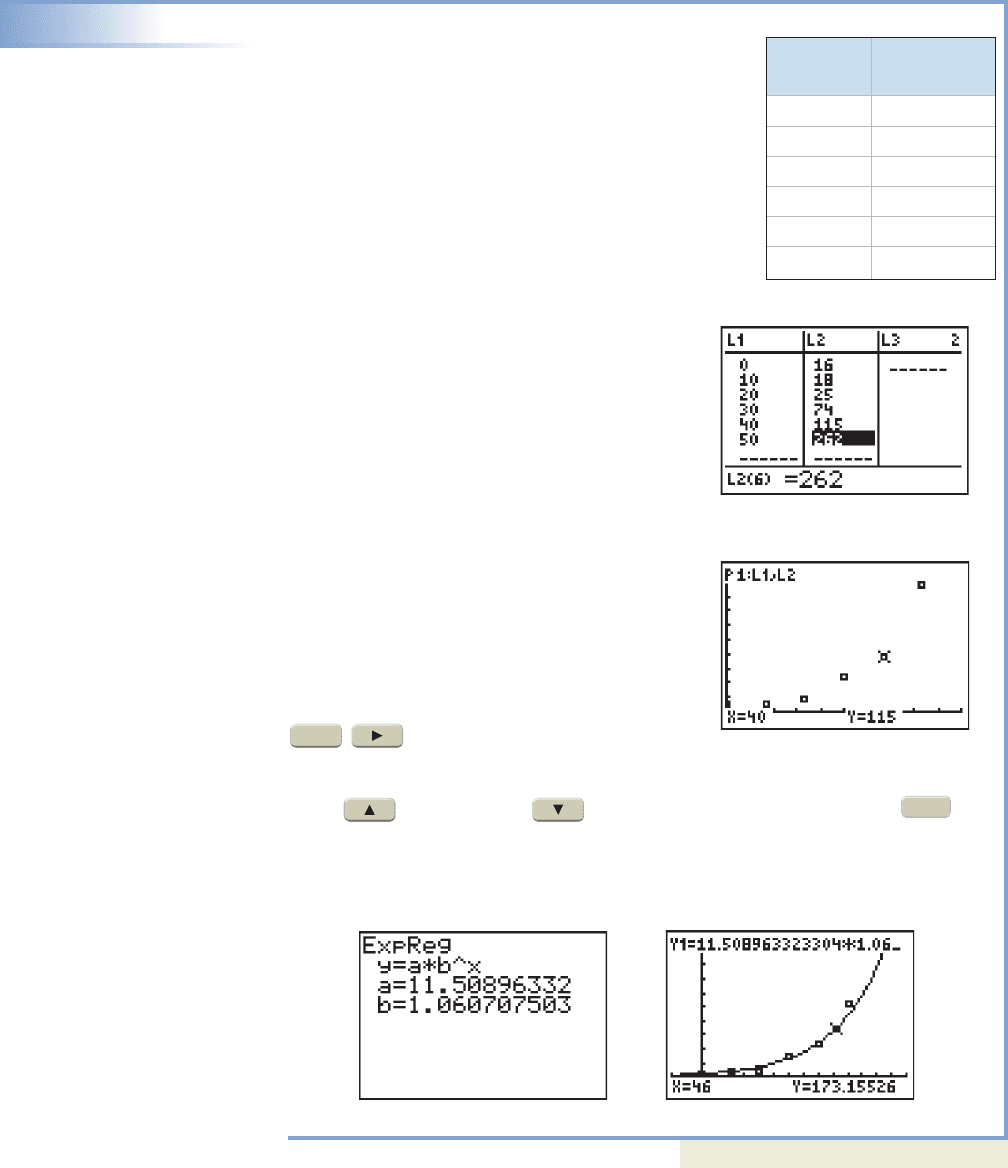
492 Modeling with Technology II Exponential, Logarithmic, and Other Regression Models MWTII–2
B. Exponential and Logarithmic Regression Models
We now focus our attention on regression models that involve exponential and loga-
rithmic functions. Recall the process of developing a regression equation involves these
five stages: (1) clearing old data, (2) entering new data, (3) displaying the data, (4) cal-
culating the regression equation, and (5) displaying and using the regression graph and
equation.
EXAMPLE 2
Calculating an Exponential Regression Model
The number of centenarians (people who are
100 years of age or older) has been climbing steadily
over the last half century. The table shows the
number of centenarians (per million population) for
selected years. Use the data and a graphing
calculator to draw the scatter-plot, then use the
scatter-plot and context to decide on an appropriate
form of regression.
Source: Data from 2004 Statistical Abstract of the United States,
Table 14; various other years
Solution
After clearing any existing data in the data lists,
enter the input values (years since 1950) in L1
and the output values (number of centenarians
per million population) in L2 (Figure
MWT II.1). For the viewing window, scale the
x-axis (years since 1950) from to 70 and
the y-axis (number per million) from to
300 to comfortably fit the data and allow room
for the coordinates to be shown at the bottom
of the screen (Figure MWT II.2). The
scatter-plot rules out a linear model. While a
quadratic model may fit the data, we expect
that the correct model should exhibit
asymptotic behavior since extremely few
people lived to be 100 years of age prior to
dramatic advances in hygiene, diet, and
medical care. This would lead us toward an
exponential equation model. The keystrokes
brings up the CALC menu,
with ExpReg (exponential regression) being
option “0.” The option can be selected by simply pressing “0,” or by using the up
arrow or down arrow to scroll to 0:ExpReg then pressing .
The exponential model seems to fit the data very well (Figures MWT II.3 and MWT
II.4). To four decimal places the equation model is
Now try Exercises 15 and 16
y 111.509021.0607
x
.
ENTER
STAT
50
10
College Algebra—
Year “t” Number “N”
(1950 0) (per million)
016
10 18
20 25
30 74
40 115
50 262
S
Figure MWT II.1
Figure MWT II.2
Figure MWT II.4
Figure MWT II.3
300
⫺50
⫺10 70
⫺10
⫺50
70
500
cob19413_ch0MWT_491-502.qxd 30/10/2008 05:38 PM Page 492 EPG 204:MHDQ069:mhcob%0:cob2chMWT2:
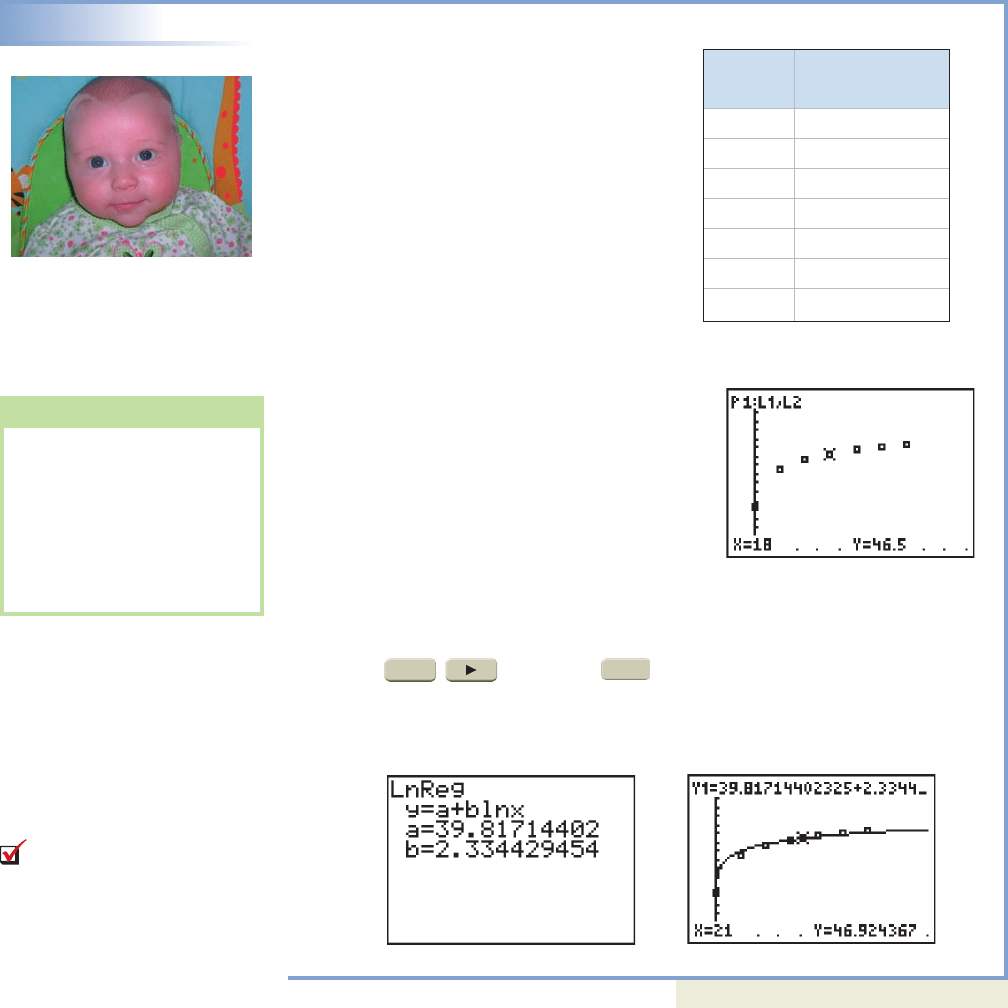
MWTII–3 Modeling with Technology II Exponential, Logarithmic, and Other Regression Models 493
EXAMPLE 3
Calculating a Logarithmic Regression Model
One measure used in studies related to infant
growth, nutrition, and development, is the
relation between the circumference of a
child’s head and their age. The table to the
right shows the average circumference of a
female child’s head for ages 0 to 36 months.
Use the data and a graphing calculator to
draw the scatter-plot, then use the scatter-plot
and context to decide on an appropriate form
of regression.
Source: National Center for Health Statistics
Solution
After clearing any existing data, enter the
child’s age (in months) as L1 and the
circumference of the head (in cm) as L2. For
the viewing window, scale the x-axis from
to 50 and the y-axis from 25 to 60 to
comfortably fit the data (Figure MWT II.5).
The scatter-plot again rules out a linear
model, and the context rules out a polynomial
model due to end-behavior. As we expect the
circumference of the head to continue
increasing slightly for many more months, it
appears a logarithmic model may be the best fit. Note that since ln (0) is undefined,
was used to represent the age at birth (rather than ), prior to running
the regression. The LnReg (logarithmic regression) option is option 9, and the
keystrokes (CALC) 9 gives the equation shown in
Figure MWT II.6, which fits the data very well (Figure MWT II.7).
Now try Exercises 17 and 18
C. Logistics Equations and Regression Models
Many population growth models assume an unlimited supply of resources, nutrients,
and room for growth, resulting in an exponential growth model. When resources
become scarce or room for further expansion is limited, the result is often a logistic
growth model. At first, growth is very rapid (like an exponential function), but this
growth begins to taper off and slow down as nutrients are used up, living space
becomes restricted, or due to other factors. Surprisingly, this type of growth can take
many forms, including population growth, the spread of a disease, the growth of a
tumor, or the spread of a stain in fabric. Specific logistic equations were encountered
in Section 4.4. The general equation model for logistic growth is
ENTER
STAT
a 0a 0.1
5
College Algebra—
WORTHY OF NOTE
For applications involving
exponential growth and
logarithmic functions, it helps
to remember that while both
basic functions are increas-
ing, a logarithmic function
increases at a much slower
rate.
Age a Circumference C
(months) (cm)
0 34.8
6 43.0
12 45.2
18 46.5
24 47.5
30 48.2
36 48.6
⫺5
25
50
60
⫺550
60
25
Figure MWT II.5
Figure MWT II.7
Figure MWT II.6
B. You’ve just learned how
to use a calculator to obtain
exponential and logarithmic
regression models
cob19413_ch0MWT_491-502.qxd 30/10/2008 01:08 PM Page 493 EPG 204:MHDQ069:mhcob%0:cob2chMWT2:

494 Modeling with Technology II Exponential, Logarithmic, and Other Regression Models MWTII–4
Logistic Growth
Given constants a, b, and c, the logistic growth P(t) of a population depends on time
t according to the model
The constant c is called the carrying capacity of the population, in that as
In words, as the elapsed time becomes very large, the population will
approach (but not exceed) c.
EXAMPLE 4
Calculating a Logistic Regression Model
Yeast cultures have a number of applications
that are a great benefit to civilization and have
been an object of study for centuries. A certain
strain of yeast is grown in a lab, with its
population checked at 2-hr intervals, and the
data gathered are given in the table. Use the
data and a graphing calculator to draw a
scatter-plot, and decide on an appropriate form
of regression. If a logistic regression is the best
model, attempt to estimate the capacity
coefficient c prior to using your calculator to
find the regression equation. How close were
you to the actual value?
Solution
After clearing the data lists, enter the input
values (elapsed time) in L1 and the output
values (population) in L2. For the viewing
window, scale the t-axis from 0 to 20 and the
P-axis from 0 to 700 to comfortably fit the data.
From the context and scatter-plot, it’s apparent
the data are best modeled by a logistic function.
Noting that Ymax and the data seem to
level off near the top of the window, a good
estimate for c would be about 675. Using logistic regression on the home screen
(option B:Logistic), we obtain the equation
Now try Exercises 19 and 20
When a regression equation is used to gather information, many of the equation
solving skills from prior sections are employed. Exercises 21 through 28 offer a
variety of these equations for practice and warm-up.
D. Applications of Regression
Once the equation model for a data set has been obtained, it can be used to interpo-
late or approximate values that might occur between those given in the data set. It can
also be used to extrapolate or predict future values. In this case, the investigation
extends beyond the values from the data set, and is based on the assumption that pro-
jected trends will continue for an extended period of time.
Y
1
663
1 123.9e
0.553x
1rounded2.
700
t Sq, P1t2S c.
P1t2
c
1 ae
bt
College Algebra—
Elapsed Time Population
(hours) (100s)
220
450
6 122
8 260
10 450
12 570
14 630
16 650
020
700
0
WORTHY OF NOTE
Notice that calculating a
logistic regression model
takes a few seconds longer
than for other forms.
C. You’ve just learned how
to determine when a logistic
model is appropriate and
apply logistics models to a
set of data
cob19413_ch0MWT_491-502.qxd 30/10/2008 01:08 PM Page 494 EPG 204:MHDQ069:mhcob%0:cob2chMWT2:
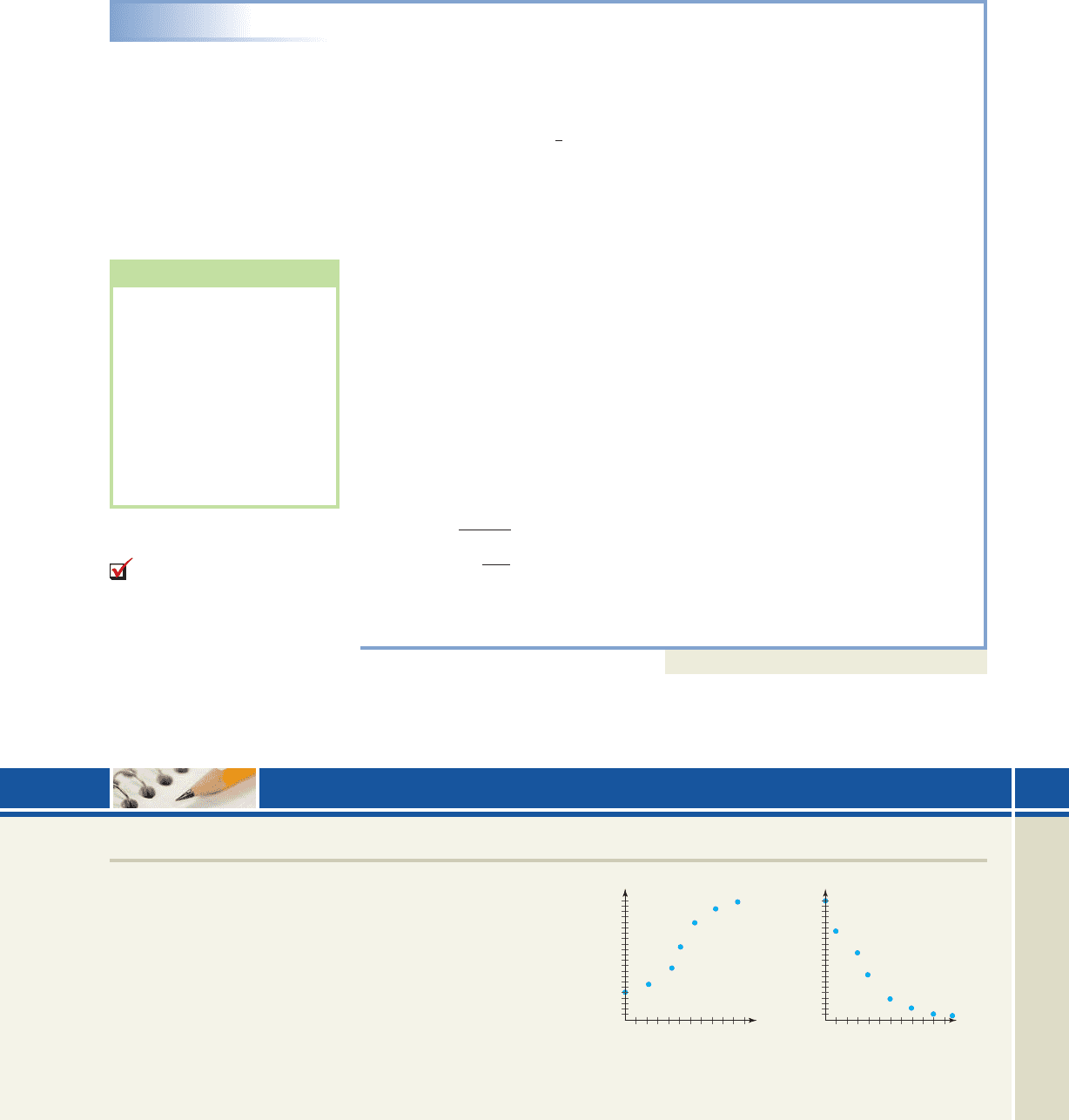
MWTII–5 Modeling with Technology II Exponential, Logarithmic, and Other Regression Models 495
Regardless of the regression applied, interpolation and extrapolation involve
substituting a given or known value, then solving for the remaining unknown. We’ll
demonstrate here using the regression model from Example 3. The exercise set offers
a large variety of regression applications, including some power regressions and addi-
tional applications of linear and quadratic regression.
EXAMPLE 5
Using a Regression Equation to Interpolate or Extrapolate Information
Use the regression equation from Example 3 to answer the following questions:
a. What is the average circumference of a female child’s head, if the child is
21 months old?
b. According to the equation model, what will the average circumference be
when the child turns years old?
c. If the circumference of the child’s head is 46.9 cm, about how old is the child?
Solution
a. Using function notation we have Substituting
21 for a gives:
substitute 21 for a
result
The circumference is approximately 46.9 cm.
b. Substituting months for a gives:
substitute 42 for a
result
The circumference will be approximately 48.5 cm.
c. For part (c) we’re given the circumference C and are asked to find the age a in
which this circumference (46.9) occurs. Substituting 46.9 for C(a) we obtain:
substitute 46.9 for C(a)
subtract 39.8171, then divide by 2.3344
write in exponential form
result
The child must be about 21 months old.
Now try Exercises 29 through 32
20.8 a
e
7.0859
2.3344
a
7.0829
2.3344
ln1a2
46.9 39.8171 2.3344 ln1a2
48.5
C1422 39.8171 2.3344 ln1422
3.5 yr 12 42
46.9
C1212 39.8171 2.3344 ln1212
C1a2 39.8171 2.3344 ln1a2.
3
1
2
College Algebra—
WORTHY OF NOTE
When extrapolating from a
set of data, care and
common sense must be used
or results can be very mis-
leading. For example, while
the Olympic record for the
100-m dash has been
steadily declining since the
first Olympic Games, it would
be foolish to think it will ever
be run in 0 sec.
D. You’ve just learned how
to use a regression model to
answer questions and solve
applications
MODELING WITH TECHNOLOGY EXERCISES
DEVELOPING YOUR SKILLS
Match each scatter-plot given with one of the following:
(a) likely linear, (b) likely quadratic, (c) likely
exponential, (d) likely logarithmic, (e) likely logistic, or
(f) none of these.
1. 2.
x
y
5
10
15
20
1050
x
y
5
10
15
20
1050
cob19413_ch0MWT_491-502.qxd 30/10/2008 05:09 PM Page 495 EPG 204:MHDQ069:mhcob%0:cob2chMWT2:
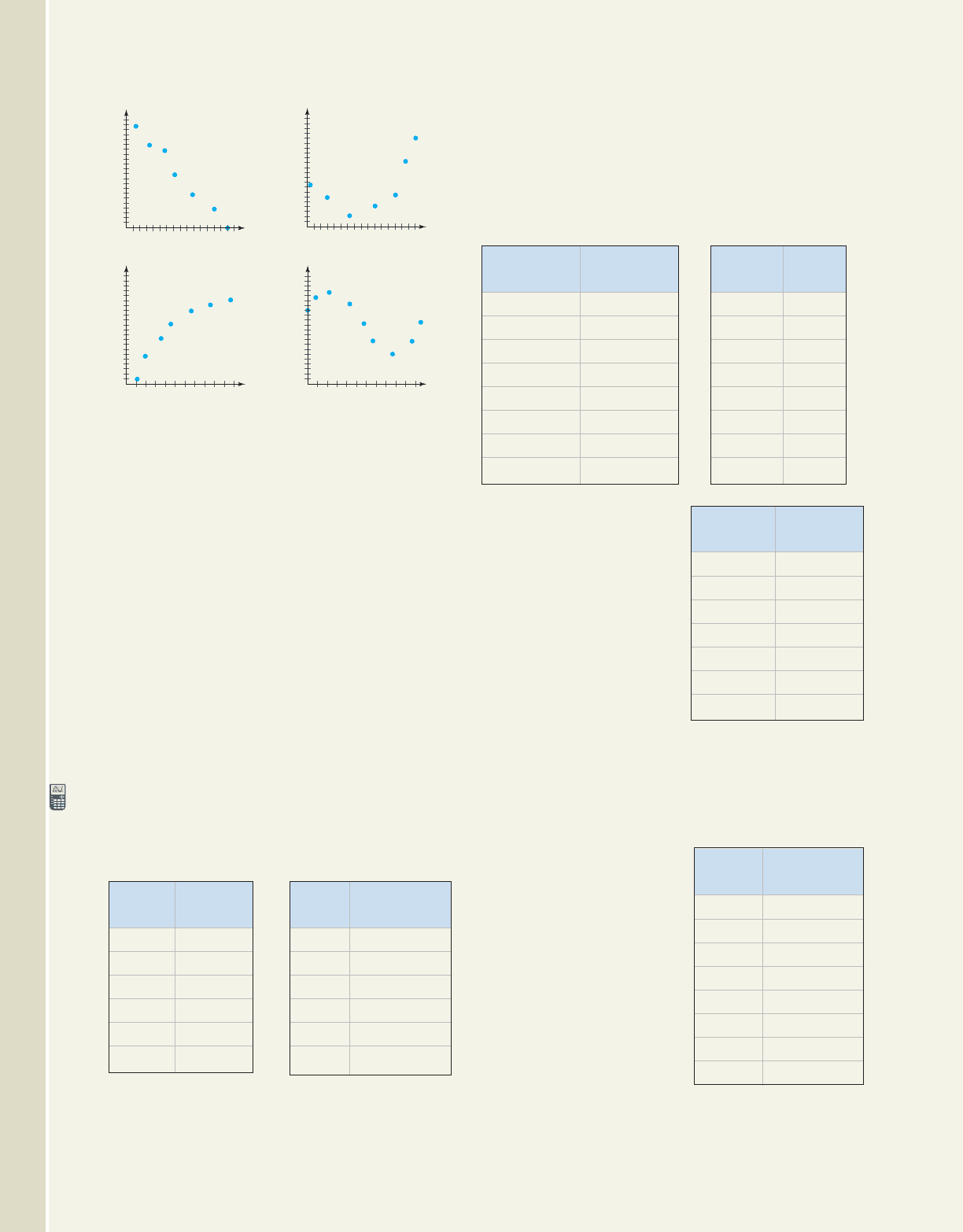
Discuss why a logarithmic model could be an
appropriate form of regression for each data set, then
find the regression equation.
17. Total number of 18. Cumulative weight of
sales compared to diamonds extracted
the amount spent on from a diamond mine
advertising
19. Spread of disease:
Estimates of the
cumulative number of
SARS (sudden acute
respiratory syndrome)
cases reported in Hong-
Kong during the spring
of 2003 are shown in
the table, with day 0
corresponding to
February 20. (a) Use
the data to draw a
scatter-plot, then use the context and scatter-plot to
decide on the best form of regression. (b) If a
logistic model seems best, attempt to estimate the
carrying capacity c, then (c) use your calculator to
find the regression equation.
Source: Center for Disease Control @ www.cdc.gov/ncidod/EID/
vol9no12.
20. Cable television
subscribers: The
percentage of American
households having cable
television is given in the
table for select years
from 1976 to 2004.
(a) Use the data to draw
a scatter-plot, then use
the context and scatter-
plot to decide on the best
form of regression. (b) If
a logistic model seems best, attempt to estimate the
carrying capacity c, then (c) use your calculator to
find the regression equation (use 1976 0).
Source: Data pooled from the 2001 New York Times Almanac,
p. 393; 2004 Statistical Abstract of the United States, Table
1120; various other years.
S
496 Modeling with Technology II Exponential, Logarithmic, and Other Regression Models MWTII–6
College Algebra—
3. 4.
5. 6.
For Exercises 7 to 14, suppose a set of data is generated
from the context indicated. Use common sense, previous
experience, or your own knowledge base to state
whether a linear, quadratic, logarithmic, exponential,
power, or logistic regression might be most appropriate.
Justify your answers.
7. total revenue and number of units sold
8. page count in a book and total number of words
9. years on the job and annual salary
10. population growth with unlimited resources
11. population growth with limited resources
12. elapsed time and the height of a projectile
13. the cost of a gallon of milk over time
14. elapsed time and radioactive decay
Discuss why an exponential model could be an
appropriate form of regression for each data set, then
find the regression equation.
15. Radioactive Studies 16. Rabbit Population
x
y
5
10
15
20
1050
x
y
5
10
15
20
1050
x
y
5
10
15
20
10 1550
x
y
5
10
15
20
10 1550
Population
Month (in hundreds)
0 2.5
3 5.0
6 6.1
9 12.3
12 17.8
15 30.2
Time in Grams of
Hours Material
0.1 1.0
1 0.6
2 0.3
3 0.2
4 0.1
5 0.06
Advertising Total Number
Costs ($1000s) of Sales
1 125
5 437
10 652
15 710
20 770
25 848
30 858
35 864
Time Weight
(months) (carats)
1 500
3 1748
6 2263
9 2610
12 3158
15 3501
18 3689
21 3810
Days After Cumulative
Outbreak Total
0 100
14 560
21 870
35 1390
56 1660
70 1710
84 1750
Year Percentage
1976 0 with Cable TV
016
4 22.6
8 43.7
12 53.8
16 61.5
20 66.7
24 68
28 70
S
cob19413_ch0MWT_491-502.qxd 30/10/2008 05:09 PM Page 496 EPG 204:MHDQ069:mhcob%0:cob2chMWT2:

since the twentieth
century. The data given
show number of post
offices (in thousands) for
selected years. Use the
data to draw a scatter-
plot, then use the context
and scatter-plot to find
the regression equation
(use ).
Source: Statistical Abstract of
the United States; The First Measured Century
a. Approximately how many post offices were
there in 1915?
b. In what year did the number of post offices
drop below 34,000?
c. According to the model, how many post offices
will there be in the year 2010?
32. Automobile value: While it is
well known that most cars
decrease in value over time,
what is the equation model for
this decline? Use the data given
to draw a scatter-plot, then use
the context and scatter-plot to
find the regression equation.
a. What was the car’s value
after 7.5 years?
b. About how old is the car if
its current value is $8150?
c. Using the model, how old is the car when
value ?
33. Female physicians: The
number of females
practicing medicine as
MDs is given in the table
for selected years. Use the
data to draw a scatter-
plot, then use the context
and scatter-plot to find the
regression equation.
Source: Statistical Abstract of
the United States.
$3000
1900 S 0
Answer the questions using the given data and the
related regression equation. All extrapolations assume
the mathematical model will continue to represent
future trends.
29. Weight loss: Harold needed to
lose weight and started on a
new diet and exercise regimen.
The number of pounds he’s lost
since the diet began is given in
the table. Draw the scatter-plot,
decide on an appropriate form
of regression, and find an
equation that models the data.
a. What was Harold’s total
weight loss after 15 days?
b. Approximately how many
days did it take to lose a total of 18 pounds?
c. According to the model, what is the projected
weight loss for 100 days?
30. Depletion of resources: The
longer an area is mined for
gold, the more difficult and
expensive it gets to obtain.
The cumulative total of the
ounces produced by a
particular mine is shown in
the table. Draw the scatter-
plot, use the scatter-plot and
context to determine whether
an exponential or logarithmic
model is more appropriate,
then find an equation that
models the data.
a. What was his total number of ounces mined
after 18 months?
b. About how many months did it take to mine a
total of 4000 oz?
c. According to the model, what is the projected
total after 50 months?
31. Number of U.S. post offices: Due in large part to
the ease of travel and increased use of telephones,
e-mail and instant messaging, the number of post
offices in the United States has been on the decline
Time Ounces
(months) Mined
5 275
10 1890
15 2610
20 3158
25 3501
30 3789
35 4109
40 4309
The applications in this section require solving
equations similar to those that follow. Solve each
equation.
21. 22.
23. 24.
4375 1.4x
1.25
4.8x
2.5
468.75
13.722.9
x
1253.9396.35 19.421.6
x
25.
26.
27. 28.
975
1 82.3e
0.423x
89052
67
1 20e
0.62x
498.53 18.2 lnx 595.9
52 63.9 6.8 lnx
MWTII–7 Modeling with Technology II Exponential, Logarithmic, and Other Regression Models 497
APPLICATIONS
Time Pounds
(days) Lost
10 2
20 14
30 20
40 23
50 25.5
60 27.6
70 29.2
80 30.7
Age of Value
Car of Car
1 19,500
2 16,950
4 12,420
6 11,350
8 8,375
10 7,935
12 6,900
Year Number
(in 1000s)
0 48.7
5 74.8
10 96.1
13 117.2
14 124.9
15 140.1
16 148.3
(1980 S 0)
College Algebra—
Year Offices
(1000s)
177
20 52
40 43
60 37
80 32
100 28
(1900 S 0)
cob19413_ch0MWT_491-502.qxd 11/23/08 13:39 Page 497

a function of time, after
the froth has reached a
maximum height. Use
the data to draw a
scatter-plot, then use the
context and scatter-plot
to find the regression
equation.
a. What was the
approximate height
of the froth after
6.5 sec?
b. How long does it take for the height of the
froth to reach one-half of its maximum height?
c. According to the model, how many seconds
until the froth height is 0.02 in.?
37. Chicken production:
In 1980, the production
of chickens in the
United States was about
392 million. In the next
decade, the demand for
chicken first dropped,
then rose dramatically.
The number of chickens
produced is given in the
table to the right for
selected years. Use the
data to draw a scatter-
plot, then use the context and scatter-plot to find
the regression equation.
Source: Statistical Abstract of the United States, 2000.
a. What was the approximate number of chickens
produced in 1987?
b. Approximately how many chickens will be
produced in 2004?
c. According to the model, for what years was the
production of chickens below 365 million?
38. Veterans in civilian
life: The number of
military veterans in
civilian life fluctuates
with the number of
persons inducted into the
military (higher in times
of war) and the passing
of time. The number of
living veterans is given
in the table for selected
years from 1950 to 1999.
Use the data to draw a
scatter-plot, then use the context and scatter-plot to
find the regression equation.
Source: Statistical Abstract of the United States, 2000.
a. What was the approximate number of female
MDs in 1988?
b. Approximately how many female MDs will
there be in 2005?
c. In what year did the number of female MDs
exceed 100,000?
34. Telephone use: The
number of telephone
calls per capita has been
rising dramatically since
the invention of the
telephone in 1876. The
table shows the number
of phone calls per capita
per year for selected
years. Use the data to
draw a scatter-plot, then
use the context and
scatter-plot to find the regression equation.
Source: The First Measured Century by Theodore Caplow, Louis
Hicks, and Ben J. Wattenberg, The AEI Press, Washington, D.C.,
2001.
a. What was the approximate number of calls per
capita in 1970?
b. Approximately how many calls per capita will
there be in 2005?
c. In what year did the number of calls per capita
exceed 1800?
35. Milk production: Since
1980, the number of
family farms with milk
cows for commercial
production has been
decreasing. Use the data
from the table given to
draw a scatter-plot, then
use the context and
scatter-plot to find the
regression equation.
Source: Statistical Abstract of
the United States, 2000.
a. What was the approximate number of farms
with milk cows in 1993?
b. Approximately how many farms will have
milk cows in 2004?
c. In what year did this number of farms drop
below 150 thousand?
36. Froth height—carbonated beverages: The height
of the froth on carbonated drinks and other
beverages can be manipulated by the ingredients
used in making the beverage and lends itself very
well to the modeling process. The data in the table
given show the froth height of a certain beverage as
498 Modeling with Technology II Exponential, Logarithmic, and Other Regression Models MWTII–8
Time Height of
(seconds) Froth (in.)
0 0.90
2 0.65
4 0.40
6 0.21
8 0.15
10 0.12
12 0.08
Year Number
(millions)
0 392
5 370
9 356
14 386
16 393
17 410
18 424
(1980 S 0)
Year Number
(millions)
0 19.1
10 22.5
20 27.6
30 28.6
40 27
48 25.1
49 24.6
(1950 S 0)
Year Number
(in 1000s)
0 334
5 269
10 193
15 140
17 124
18 117
19 111
(1980 S 0)
College Algebra—
Number
Year (per capita/
per year)
038
20 180
40 260
60 590
80 1250
97 2325
(1900 S 0)
cob19413_ch0MWT_491-502.qxd 10/30/08 8:33 PM Page 498
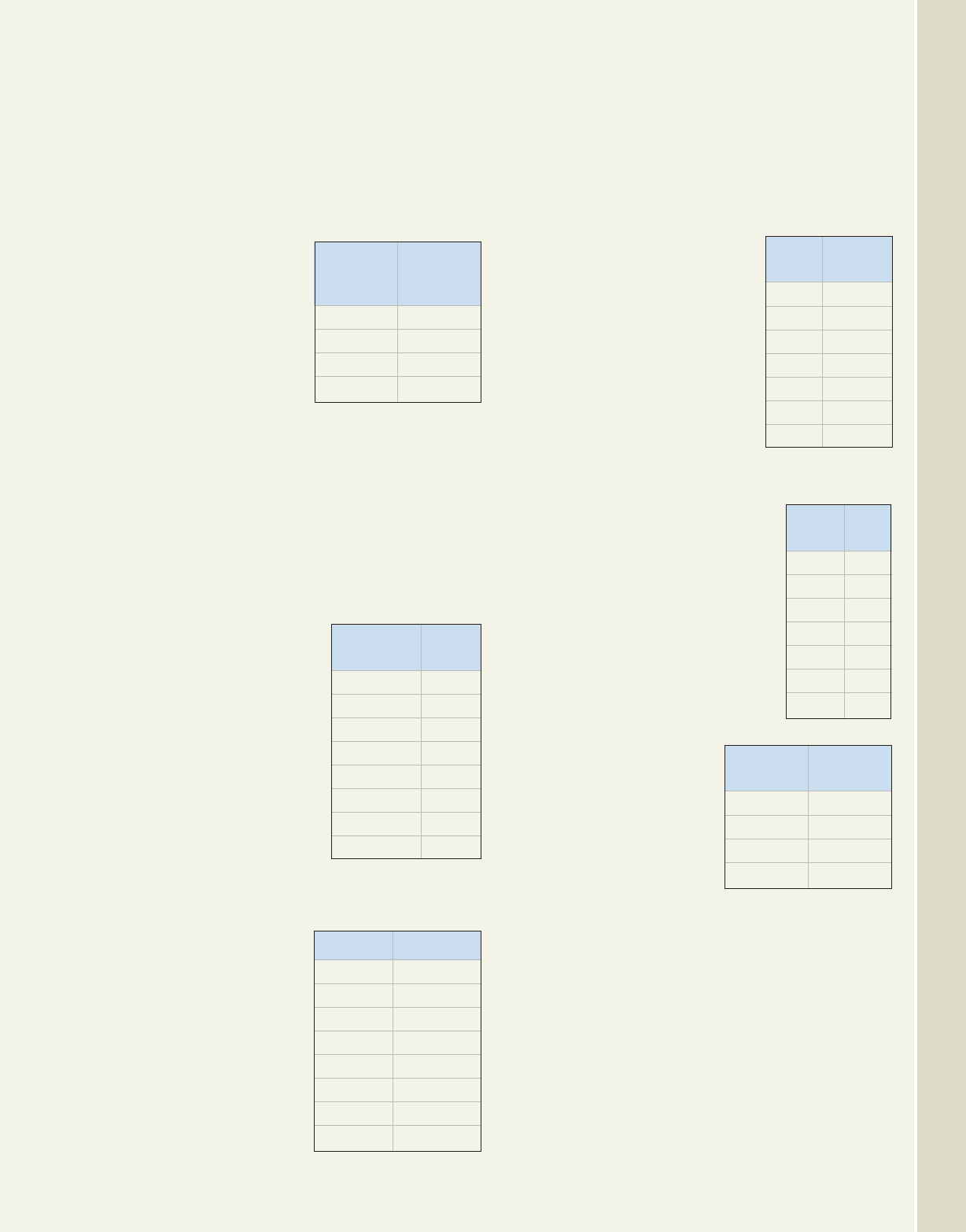
data to draw a scatter-plot, then use the context and
scatter-plot to find the regression equation.
According to the model, what is the predicted
percentage of the population living in Pacific
coastal areas in 2005 and 2010?
Source: 2004 Statistical Abstract of the United States, Table 23.
42. Water depth and pressure:
As anyone who’s been
swimming knows, the deeper
you dive, the more pressure
you feel on your body and
eardrums. This pressure (in
pounds per square inch or psi)
is shown in the table for
selected depths. Use the data
to draw a scatter-plot, then use
the context and scatter-plot to
find the regression equation.
According to the model, what
pressure can be expected at a depth of 100 ft?
43. Personal debt-load: The data
given tracks the total amount of
debt carried by a family over a
6-month period. Use the data to
draw a scatter-plot, then use the
context and scatter-plot to find
the regression equation.
According to the model, how
much debt will the family have
by the end of December? When
will their debt-load exceed
$10,000?
44. Use of debit cards:
Since 1990, the dollar
volume of business
transacted using debit
cards has been growing.
The volume of business
nationwide is given in
the table to the right for
selected years. Use the
data to draw a scatter-plot, then use the context and
scatter-plot to find the regression equation.
Source: Statistical Abstract of the United States, 2004.
a. In 1993, what was the approximate dollar
volume of business transacted with debit cards?
b. Approximately how much dollar volume of
business was transacted in 1997?
c. In what year did the volume of business
transacted using debit cards exceed 1000 billion?
45. Musical notes: The table shown gives the
frequency (vibrations per second for each of the
twelve notes in a selected octave) from the
a. What was the approximate number of living
military veterans in 1995?
b. Approximately how many living veterans will
there be in 2006?
c. According to the model, in what years did the
number of veterans exceed 26 million?
39. Use of debit cards:
Since 1990, the use of
debit cards to obtain
cash and pay for
purchases has become
very common. The
number of debit cards
nationwide is given in
the table for selected
years. Use the data to
draw a scatter-plot, then use the context and
scatter-plot to find the regression equation.
Source: Statistical Abstract of the United States, 2000.
a. Approximately how many debit cards were
there in 1999?
b. Approximately how many debit cards will
there be in 2005?
c. In what year did the number of debit cards
exceed 300 million?
40. Quiz grade versus study
time: To determine the
value of doing homework,
a student in college algebra
records the time spent by
classmates in preparation
for a quiz the next day.
Then she records their
scores, which are shown in
the table. Use the data to
draw a scatter-plot, then
use the context and scatter-
plot to find the regression
equation. According to the
model, what grade can I expect if I study
for 120 min?
41. Population of coastal
areas: The percentage of
the U.S. population that
can be categorized as
living in Pacific coastal
areas (minimum of 15%
of the state’s land area is
a coastal watershed) has
been growing steadily
for decades, as indicated
by the data given for
selected years. Use the
MWTII–9 Modeling with Technology II Exponential, Logarithmic, and Other Regression Models 499
Number
Year of Cards
(millions)
0 164
5 201
8 217
10 230
(1990 S 0)
Year Volume
(billions)
012
562
8 239
10 423
(1990 S 0)
xy
(min study) (score)
45 70
30 63
10 59
20 67
60 73
70 85
90 82
75 90
Depth Pressure
(ft) (psi)
15 6.94
25 11.85
35 15.64
45 19.58
55 24.35
65 28.27
75 32.68
Month Debt
(x)(y)
(start) $0
Jan 471
Feb 1105
March 1513
April 1921
May 2498
June 3129
College Algebra—
Year Percentage
1970 22.8
1980 27.0
1990 33.2
1995 35.2
2000 37.8
2001 38.5
2002 38.9
2003 39.4
cob19413_ch0MWT_491-502.qxd 30/10/2008 01:08 PM Page 499 EPG 204:MHDQ069:mhcob%0:cob2chMWT2:
